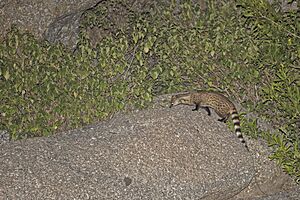Small Indian civet facts for kids
Quick facts for kids Small Indian civet |
|
|---|---|
 |
|
| In Silchar, Assam, India | |
| Conservation status | |
| Scientific classification | |
| Genus: |
Viverricula
|
| Species: |
indica
|
| Subspecies | |
 |
|
| Small Indian civet range (green - extant, pink - probably extant) |
|
The small Indian civet (Viverricula indica) is a type of civet. It lives in parts of South and Southeast Asia. This animal is listed as Least Concern on the IUCN Red List. This means it is not currently in danger of disappearing. It lives in many places, including farms and forests that have grown back.
This civet is the only species in its genus, which is called Viverricula.
Contents
What They Look Like
The small Indian civet has fur that feels a bit rough. Its fur can be brownish-grey or a light yellowish-brown. It usually has several black or brown stripes along its back. It also has rows of spots on its sides. There are often five or six clear stripes on its back. On each side, there are four or five rows of spots.
Some civets have stripes and spots that are not very clear. Their fur underneath is brown or grey. The grey hairs on top often have black tips. Its head is grey or brownish-grey, and its chin is often brown. The ears are short and round. There is a dark mark behind each ear and one in front of each eye. Its feet are brown or black.
The civet's tail has black and whitish rings that go back and forth. It usually has seven to nine rings of each color. From its head to its body, it is about 53 to 58 centimeters (21 to 23 inches) long. Its tail is about 38 to 43 centimeters (15 to 17 inches) long.
Where They Live
The small Indian civet lives in many countries. These include most of India, Sri Lanka, Myanmar, Thailand, Laos, Cambodia, Vietnam, and parts of China and Taiwan. It used to live in Bhutan, Bangladesh, Peninsular Malaysia, Java, and Bali, but we don't have recent records from those places. We are not sure if it still lives in Singapore.
These civets live in different kinds of places. In Chitwan National Park in Nepal, they live in grasslands and Sal forests. In Dachigam National Park in India, one was seen in a riverine forest at 1,770 meters (5,807 feet) high. In northeast India, they have been found up to 2,500 meters (8,200 feet) high.
In India's Western Ghats, they have been seen in grasslands and near rivers. They were also seen near tea farms. In Mudumalai Tiger Reserve, they live in different types of forests. These include deciduous forests (where trees lose leaves) and thorn forests. During dry times, they are seen near water holes.
In Myanmar, they live in mixed forests with bamboo. In Thailand, they are found in evergreen forests and other types of forests. In Laos, they live in many habitats, like forests, scrubby areas, and grasslands. In Cambodia, they are often found near water and in marshes. In China, they live in subtropical forest patches.
Civets in East Africa
The small Indian civet was also brought to Madagascar. Wild civets have been seen in different national parks there. They were also brought to Pemba Island and Mafia Island in Africa. People used to keep them there for their musk. This musk was used in traditional African medicine and as a scent for perfume.
How They Live
Small Indian civets are mostly active at night. They usually stay on the ground. They eat mostly insects. They live in holes in the ground, under rocks, or in thick bushes. Sometimes, a male and female civet will stay together for mating and hunting. In places where people don't bother them, they might even hunt during the day.
Even though they mostly stay on the ground, they can climb trees well. They sleep in burrows or hollow logs. They can dig their own burrows. They also use burrows that other animals have left. In towns, they might use gutters or other dark, hollow places as temporary homes.
What They Eat
Small Indian civets eat many things. They feed on rats, mice, and birds. They also eat snakes, fruit, roots, and dead animals (called carrion). Sometimes, they have been seen taking chickens from farms.
Reproduction
Female civets usually have four or five young ones at a time. Civets kept in zoos in Kerala, India, were seen mating from March to May and again from October to December. Pregnancy lasts about 65 to 69 days. Baby civets weigh about 90 to 110 grams (3.2 to 3.9 ounces) when they are born. They open their eyes after about five days. They reach 1,000 grams (2.2 pounds) when they are about ten weeks old.
In captivity, these civets can live for eight to nine years.
Protecting Them
The small Indian civet is listed on CITES Appendix III. This means that trade of this animal is controlled to prevent it from becoming endangered. In Myanmar, it is fully protected by the Wildlife Act of 1994.
Naming the Civet
The scientific name for this animal is Civetta indica. This name was given by Étienne Geoffroy Saint-Hilaire in 1803. He described a civet skin from India. Later, in 1838, Brian Houghton Hodgson gave it the generic name Viverricula. This was when he described new animal groups from Nepal.
Over time, different scientists gave other names to civets that looked a bit different. However, many of these were later considered to be just different types of the same species. Today, Viverricula indica is the main accepted name for the small Indian civet.



